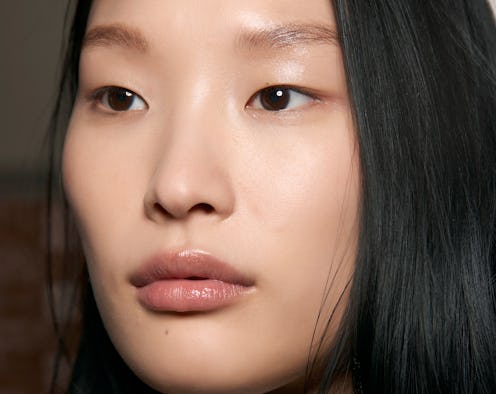(Beauty)
The Sunscreen Problem That Might Be Affecting You Now — Even During Winter

It can be almost impossible to pinpoint the source of a skin reaction. Is it the cold weather? Is it that new moisturizer? Is it a new laundry detergent? The list goes on. Less frequently considered, however, is sunscreen allergies, which are actually incredibly common, but usually because of two key ingredients. So if you're convinced that chemical sunscreens are for you, the experts say that if you have sensitive skin, you may want to reconsider.
"It is not that people are allergic to sunscreen as a whole," Dr. Dianne Davis, MD, FAAD, Dallas dermatologist says. "Some may have a sensitivity or allergy to a particular ingredient, fragrance, preservative, or another component of the sunscreen product. And sometimes it could be that the reaction is a result of using a sunscreen with another topical medication, lotion, or cream that is already on the body." However, Dr. Davis emphasizes that in most cases, reactions to sunscreen stem from chemical sunscreens in particular. "While chemical sunscreens are a great option to protect the skin from the harmful UV rays, chemical sunscreens may clog pores or ultimately cause skin irritation," she says.
She lists two of the most common ingredients in chemical sunscreens that cause reactions as avobenzone and oxybenzone. "These chemicals work to convert UV rays into heat to avert it from absorption by the skin." Dr. Davis says. She notes that compared to physical sunscreens, which are notably more gentle on skin, chemical sunscreens are much thinner and can quickly and fully blend into the skin. However, one must wait 30 minutes after application for them to take effect and provide full protection. It's also worth mentioning that while chemical sunscreen do in fact blend more easily, and are more forgiving to deeper skintones, according to the FDA, it can be absorbed into the bloodstream, often serving as another deterrent for many.
Reactions to sunscreens can manifest in an array of symptoms. "These sensitivities can appear from mild to severe reactions," Dr. Davis says. "The most common being irritant contact or allergic contact dermatitis. An irritation contact dermatitis can appear as mild redness or as a stinging sensation, while an allergic contact dermatitis usually presents with an itchy sensation and sometimes bumps and blisters." She says that a rarer type of sunscreen reaction can be a photocontact dermatitis, which occurs where the product has been applied to the body. It may appear as a severe sunburn or eczema and most commonly appears on the face, arms, back of the hands, and lower neck. But no need to freak out. Dr. Davis says that reactions can easily be treated, but may need the help of a professional. "If one feels they are having a reaction to their sunscreen or a particular ingredient such as avobenzone or oxybenzone, I recommend they cease use of the product immediately and have an evaluation by their board-certified dermatologist to help assess the type of reaction they are having and help discern what may have caused the reaction," she says.
Another bit of good news is that while SPF is still necessary — even during the winter — chemical sunscreens are not, and there are tons of other options out there. And considering that we're indoors more these days and the amount of sun exposure during the winter is less, the need for chemical sunscreen is less crucial. "I like to recommend physical sunblocks such as zinc oxide or titanium dioxide because instead of being absorbed into the skin they sit on top of the skin and deflect the sun’s harmful rays," Dr. Davis says. "This type of sunscreen is unlikely to clog pores as it remains on the skin’s surface, and they can even provide a moisturizing benefit." However, physical sunblock can also be less resistant to sweat and water. "One caveat with physical sunscreens is that it does not always blend into the skin very well and often leaves behind white streaks," Dr. Davis says. "To avoid streakiness, look for sunblock in tinted versions, or I recommend that patients can mix their sunblock with their sunscreen to help it blend into the skin."
We only include products that have been independently selected by The Zoe Report's editorial team. However, we may receive a portion of sales if you purchase a product through a link in this article.